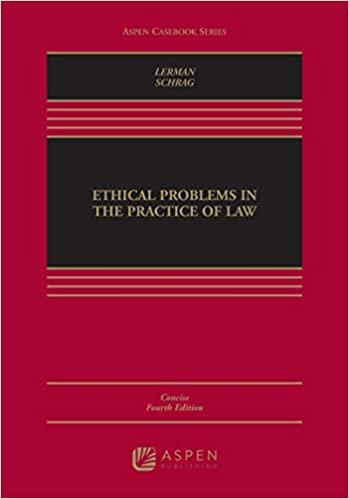Question
Arvin, Inc. developed a new product so revolutionary that Arvin soon controlled 85 percent of the market. The Justice Department sued Arvin for violating the
Arvin, Inc. developed a new product so revolutionary that Arvin soon controlled 85 percent of the market. The Justice Department sued Arvin for violating the Sherman Act. Arvin's best defense would be
the rule of reason.
the thrust-upon defense.
conscious parallelism.
none of the above. This is a per se violation constituting monopolization.
Ace produced and sold all types of household cleaning supplies except bleach. Ace decided to add bleach to its product line by purchasing Kleen, the largest bleach producer in the country. If the government challenges this acquisition as a prohibited merger, what argument will the government be most likely to use?
Ace was a potential entrant into the bleach market.
The acquisition will begin a concentration trend within the cleaning industry.
The merger is a prohibited vertical merger.
The merger is a prohibited horizontal merger.
If a store advertises a particular product at a very attractive price, and then tries to talk prospective buyers of that product into buying a more expensive brand or style when the customers enter the store, the store would appear to be guilty of
palming off goods.
an unfair trade practice.
a deceptive trade practice.
bait and switch advertising.
false advertising.
discrimination.
This case, ___________________________is a landmark in U.S. antitrust law involving relevant product market.
Standard Oil Co. v. United States
United States v. E.I. DuPont de Nemours and Co.
Standard Oil Co. (of Indiana) v. FTC
American Needle, Inc v. National Football League
None of the above.
The government, in a number of monopolization cases over the years, has used the Sherman Act quite successfully, beginning with ___________________________ decided in 1911
Standard Oil Co. v. United States
United States v. E.I. DuPont de Nemours and Co.
Standard Oil Co. (of Indiana) v. FTC
American Needle, Inc v. National Football League
None of the above
The ___________________ case is a landmark opinion, involved an allegation of price discrimination and a defense of meetingbut not beatingthe competition.
Standard Oil Co. v. United States
United States v. E.I. DuPont de Nemours and Co.
Standard Oil Co. (of Indiana) v. FTC
American Needle, Inc v. National Football League
None of the above
Maggie disputed a piece of information about her in a credit report prepared by WRT, Inc., a professional credit bureau. WRT investigated the information, but does not agree with Maggie's position. Maggie has subsequently filed a statement setting forth the nature of the dispute. WRT has no grounds to believe that Maggie's claim is frivolous, but also does not agree with it. In subsequent credit reports, WRT
must remove the disputed information altogether.
must accompany the disputed information with a note that Maggie disputes it and provide Maggie's statement or an accurate summary thereof.
must accompany the disputed information with a note that Maggie disputes it, but does not need to include Maggie's position.
may print the disputed information without comment.
Under the provisions of the federal Consumer Credit Protection Act (TILA), the consumer credit customer must be informed of
the procedures for complaining about a billing error.
the opportunity to examine his or her credit file, and the ability to object to allegedly erroneous materials or information.
the annual percentage rate of all finance charges imposed on the credit account.
the availability of credit life insurance protection on all consumer credit accounts.
Step by Step Solution
There are 3 Steps involved in it
Step: 1

Get Instant Access to Expert-Tailored Solutions
See step-by-step solutions with expert insights and AI powered tools for academic success
Step: 2

Step: 3

Ace Your Homework with AI
Get the answers you need in no time with our AI-driven, step-by-step assistance
Get Started


